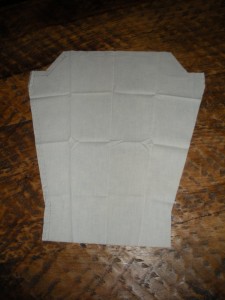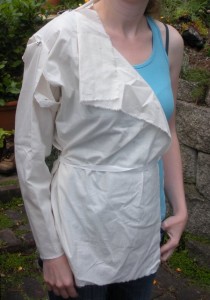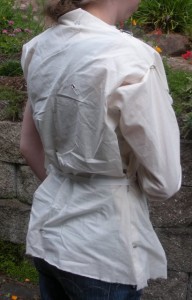- I want to knit a sweater
- > Customizing the fit of a sweater *before* I make it <
I said that I wanted to customize the fit of this sweater, and my theory is that it’ll be better to fix before I get started, rather than after I’ve made it and am disappointed. To that end—being the seamstress that I also am—I decided to make a cloth mock-up, so I could see what it’ll look like on me. I decided to use muslin, for the simple reasons that it’s super-cheap (~ $1/yd.) and that thin cotton is easy to work with.

Fortunately, this pattern comes with expected dimensions, and I have sharpies, a ruler, and a basic sense of geometry. So I drew the pattern directly onto the fabric, adding a 5/8 in. seam allowance to each edge that was meant to be sewn together. Unfortunately, I forgot that the pattern already included a 1-stitch selvage. The gauge is 16 stitches per 4 inches, or about 1/4 inch per stitch. So, if I wanted 5/8 in. seam allowance, I could’ve just added 3/8 in. I noticed this before I sewed anything together, and sewed 7/8 in. seams to get a proper sense of how it will fit.
The other thing was that despite its cheapness, I didn’t want to use up as much fabric as it would take to make the whole sweater. Since this was just a mock-up to get a sense of how it would fit, I created the whole back, one front, and one sleeve. Three seams later (I didn’t bother setting the sleeve into the sweater… I hate putting in sleeves), I had a pseudo-sweater and a sleeve. At first I tried to just put the pseudo-sweater on myself, but I realized I wasn’t getting a good sense of where it would hang on me, so I safety-pinned the critical points (shoulders, center back, side seams) to a tank-top.

This sweater is meant to be baggy. I’m ok with that. But here’s the thing. Yarn is forgiving. You can make it much smaller than you’d ever make something woven, and it’ll still fit just fine, because (in general, and obviously this varies depending on the yarn and the stitch) it’ll stretch. Also, with a bottom hem that just hangs down and isn’t tight to the body, no ribbing around the hips or anything, it’s likely to stretch out and become even baggier, one direction or another. So starting out with a too-baggy sweater, it’ll only become an even more too-baggy* sweater.
The pseudo-sweater seemed to fit just fine around the hips, but around the waist it looked huge on me. Turns out I’m not square-shaped. So, I measured the difference between my hips and the narrowest point of my waist, and divided that by 4 to pick a starting point for how much to leave out of each quarter of the sweater (front left, front right, back left, back right). Then I tucked in and pinned the side-seam by approximately that much (I totally eyeballed it, not having my measuring tape handy), and was impressed by the improvement. It would still be loose, but not crazy-baggy.

The next questions are: where do I make that dart**, do I make the dart in both front and back or only the back, and after I’ve decreased that much do I want to increase again back to the hip-width, or do I want the shoulders to be a little narrower, too? Everything I can find about making vertical darts in sweaters indicates I should decrease at the side-seam, not in the back like I would if I were sewing a shirt, but no one seems to explain why. While I will go with that theory, I’m still waiting for the why. Since I took in the proper amount from both the front and the back in my pseudo-sweater, and it looked just fine, I think the darts should be symmetrical about the side-seams. Double-decreases, and double-increases. The third question, I’m going to play by ear. I could see increasing to get the shoulders to nearly the width of the hips, without affecting how the sleeves will fit. From there, I’ll also have to play the sleeves by ear. From the fabric mock-up, they seemed about the right length or a little short, so it’ll just be a matter of how the yarn actually behaves.
So, I think I’ve identified all of the sizing changes. Decrease several inches, with the decrease vertically centered at my waist (careful measurement and attention will be required for that…), then increase probably 2/3s as much as I decreased. And then pay attention to sleeve length as I go.
No problem! o_O
——
* Check me out, rockin’ the descriptive adjectives. Oh yeah.
** In knitting, they use the term dart just like in sewing. But in sewing, a dart is where you cut out and sew together fabric, to make a 3D shape out of flat fabric. In knitting, you just don’t knit those stitches, so they never exist. Trippy.